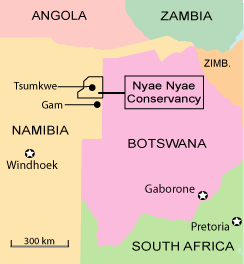Over the past year, Herero farmers have been invading the Ju/’hoansi territory—the Nyae Nyae Conservancy—in Namibia. The nation does not seem able, or willing, to help. AllAfrica.com, a large Internet distributor of news about Africa, ran a story last week on the first anniversary of the invasion. The current situation sounds quite discouraging for the peaceful San people.
 In May 2009, some Herero farmers from Gam, a community immediately south of the Nyae Nyae Conservancy, cut the Nyae Nyae reserve fences and invaded with their cattle, and as of last November, legal negotiations were still going on. The national government seemed to be mostly concerned about destroying the cattle the invaders had brought into the reserve because some wild animals in the Ju/’hoansi territory may have become infected with foot and mouth disease. International certification that the beef industry is absolutely free from the disease is important to the nation’s economy. Last week’s news story provides an important update.
In May 2009, some Herero farmers from Gam, a community immediately south of the Nyae Nyae Conservancy, cut the Nyae Nyae reserve fences and invaded with their cattle, and as of last November, legal negotiations were still going on. The national government seemed to be mostly concerned about destroying the cattle the invaders had brought into the reserve because some wild animals in the Ju/’hoansi territory may have become infected with foot and mouth disease. International certification that the beef industry is absolutely free from the disease is important to the nation’s economy. Last week’s news story provides an important update.
Ju/’hoansi leaders last summer were concerned about the problems caused by the invaders living in their communities—destruction of the natural desert environment, introduction of alcohol, and too many children in the schools. A year ago, there were 38 invaders from Gam. Now there are eight times as many, at least 300. Ben Begbie-Clench, Acting Regional Coordinator for an NGO called the Working Group of Indigenous Minorities in Southern Africa (WIMSA), compares the invaders to refugees. They already have land allocations in the Gam area but they refuse to live there, he says.
While the constitution of Namibia guarantees citizens the right to live anywhere in the country, the Nyae Nyae Conservancy property is different. It is governed by a traditional authority, a chief who must give permission for outsiders to live in his territory. The Legal Assistance Centre, which was working with the Ju/’hoansi in November, indicated for the story last week that the Ju/’hoansi chief “is the only person that can allocate residential and farming units.”
Moses K. !Coma, a councilor in the region, said he did not really understand why the farmers had invaded. Their excuse is that they feared a plant called poison-leaf, which grows in their area and will kill their cattle, even though the same plant also grows in the Nyae Nyae Conservancy. The situation is calm according to !Coma—most of the invaders have settled in the town, Tsumkwe, in the reserve.
The Ju/’hoansi chief, Bobo, contradicted him. It is not quiet. “There are too many dogs, donkeys and horses,” he said. He added that at night in Tsumkwe, drunken fights cause unrest among the Ju/’hoansi and the Herero. He alleged that the Herero men are threatening and intimidating the San people. Theft is also becoming a problem. He indicates that more and more Herero are invading, daily. “Tsumkwe is almost full,” the chief said.
The chief dismissed the excuse about the poison leaf. There is a lot of it in the Ju/’hoansi reserve. He also dismissed the Herero excuse that there is not enough grass available to them in the Gam region. He expressed hope that the government will support their attempts to have the invaders removed.
Mr. Begbie-Clench was concerned about the impact the invaders were having on the natural and human resources in the Nyae Nyae Conservancy. “The San are suffering the most from the situation. I suspect there is a loss of natural resources because of the extra people in the area. The area exists without much money and resources and the natural environment therefore holds much importance.”
He added that since the Ju/’hoansi try hard to avoid conflict situations, they can easily be coerced by other people such as the Herero farmers.